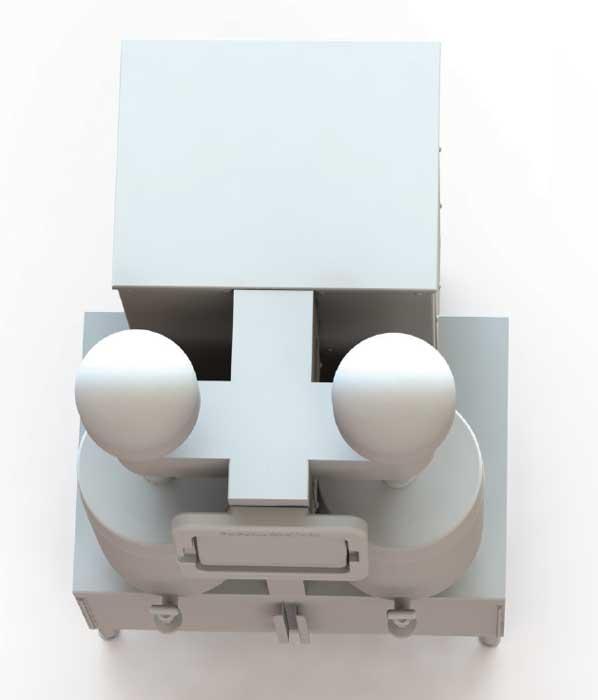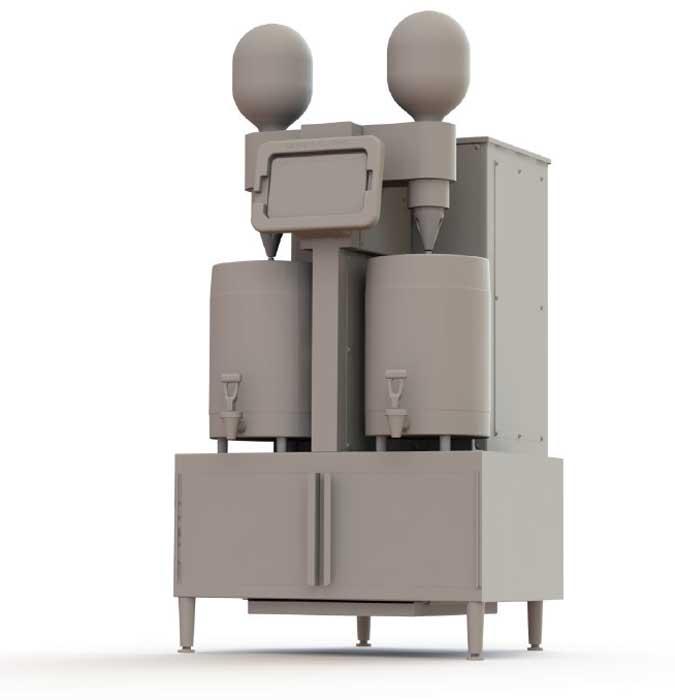Contributing Writer
- FMA
- The Fabricator
- FABTECH
- Canadian Metalworking
Categories
- Additive Manufacturing
- Aluminum Welding
- Arc Welding
- Assembly and Joining
- Automation and Robotics
- Bending and Forming
- Consumables
- Cutting and Weld Prep
- Electric Vehicles
- En Español
- Finishing
- Hydroforming
- Laser Cutting
- Laser Welding
- Machining
- Manufacturing Software
- Materials Handling
- Metals/Materials
- Oxyfuel Cutting
- Plasma Cutting
- Power Tools
- Punching and Other Holemaking
- Roll Forming
- Safety
- Sawing
- Shearing
- Shop Management
- Testing and Measuring
- Tube and Pipe Fabrication
- Tube and Pipe Production
- Waterjet Cutting
Industry Directory
Webcasts
Podcasts
FAB 40
Advertise
Subscribe
Account Login
Search
A 3-D CAD modeling case study: Focus on industrial design limits attention paid to future manufacturability
Industrial designers need to quickly produce a range of options; manufacturing professionals need to adapt the design to suit a controlled process
- By Gerald Davis
- February 8, 2018
- Article
- Shop Management

Figure 1
The industrial design team wants excitement and mystery in the design. The design for manufacturing team generally does not view excitement and mystery in the same way.
Design for manufacturing (DFM) might be considered as an advertised service for job shops to supplement the cash flow from batch-oriented fabrication.
Fabricators naturally have great insight into their manufacturing processes. Those skills in DFM might translate into CAD services-for-hire. A closely related theme is the fabrication of one-offs in the form of pre-prototypes. To dramatize the opportunities and pitfalls in product development as a trade, we are following the actual history of a coffee brewer suitable for high-end, high-volume restaurants.
Disclaimer: This is a story about a pair of inventors doing their best without the benefit of experience in manufacturing. There is some misdirection in the retelling of this tale to help others avoid some of the obstacles these inventors faced.
The previous edition of this column (“Design for manufacturing in cooperation with industrial design,” January 2018, The FABRICATOR®, p. 46) introduced an invention’s development from concept to its industrial design (ID) stage. The business plan included a major tradeshow that loomed only months away from when the design was to be completed. Presenting a working machine at that tradeshow was mandatory for success of the product launch. If the inventors’ dreams were to come true, they needed to find sustained funding for refining the coffee maker design for batch manufacturing. If their product didn’t make it to the tradeshow, they would have needed to revise the business plan substantially. There isn’t any funding for that.
Our heroes were in a near panic to translate work from their industrial design team into a cabinet for display at a tradeshow. With our hindsight, we know that they had success at the tradeshow. That’s the tragedy of this tale: They got exactly the cabinet that they asked for. It strongly resembled a mockup rather than a finished product. Let’s take a closer look at how that came to be.
Industrial Design as a Process
Time is not a luxury afforded many manufacturers, so an efficient decision-making process is helpful. Funding is another lacking luxury, so the cost of raw material and labor is a constant pressure.
It is no surprise that hand-drawn concept sketches make a good start to the ID process. Sketches on white board and paper do not cost much in terms of raw material. Because no one has seen the finished product yet, some exploration is required. All options are good at this early stage.
The “better or worse” routine of an optometrist’s eye examination is a good example of controlled exploration. The ID team is likely to use a similar presentation technique to help their clients make aesthetic decisions. A product with a jug, tank, and basket might be sketched several ways to show options for appearance. The tank in the middle with the basket below might be the best, but only the client knows. In the beginning of any design job, the client doesn’t trust instinct. The clients want an expert to tell them what looks good.
During an ID exploration meeting, the designers may be forced into some mind reading. Words discover new meanings as people grope to describe their vision. I’ve met industrial designers who are adept at nonverbal communication. Many have made a lifetime’s study of predicting how people will react to objects. I’m afraid their ID didn’t rub off on me any more than my DFM rubbed off on them.
Industrial designers help their clients say things like “that image projects strange science,” “looks battle-ready,” or “that looks lightweight.” Once a statement of opinion has been made, the next exploration is, “Do you want more or less of that?”

Figure 2
This white cardboard mockup has solved the physical layout problem. What is the best way to translate this into a one-off sheet metal version? We need lovely grained stainless steel for a restaurant setting.
The skilled industrial designer likely will know Robert Southey’s 1837 poem “The Three Bears.” Initial concept sketches seek to define limits that are “too hot” or “too cold.” It is possible that one or a few of the initial drawings will be just right, but most of the sketched ideas and images will be discarded.
Acceptance of rejection is natural to the ID team. The willingness to produce a pretty drawing and then toss it is not much different from the optometrist’s affection for one diopter over another. It doesn’t matter that the sketch is pretty. What matters is the design idea the image evokes.
I’m belaboring the disposable point because of the likely readership of this column. To those trained in quality control and process management, such as a typical crew in a precision job shop, random production is anathema—a thing of evil. Some job shops will not start fabrication without a very high probability of success. Rejected items are cause for corrective action. Working with the ID team requires a different outlook on accept/reject criteria. Precision matters, but in a different way.
Sketching in 3-D CAD (see Figure 1) can be a productive way to create a collection of illustrations to represent design options in shape, color, and texture. The best features of such computer-rendered models are selected for further refinement in the pre-prototype.
The main difference between CAD for ID and CAD for DFM is the probability that the CAD model will be discarded. The ID team sees all things as transient. Faster is better, only CAD-model the minimum amount of detail. In contrast, the DFM team is trying to cast things—sometimes in stone, metal, plastic, or other materials. DFM cares about detail and process; ID cares not a whit about how it will be made because it is all about emotion. That is not because the ID team is ignorant or uncaring. The ID mission is to allow others to see a range of options. The trick is for DFM to help but not hinder ID. The mutual goal is to produce a mockup that smoothly makes the transition to fabrication.
Before we reveal that trick, let’s take a brief look at balancing the physical and the image.
Virtual Prototype Versus Cardboard Mockup
The ID team often translates design goals derived from illustrations into accurately scaled physical representations. In the case of the preliminary designs for the coffee brewer, white cardboard models were fabricated in 1-to-1 scale (see Figure 2). These mockups were sturdy enough to allow our heroes to quickly winnow the good ideas from the unworkable ones. In particular, they could wave their hands as if they were operating the machine. As a result of this ID exercise, the location of the control panel became an important part of the design.
The touch and feel of ID sculptures, the pre-prototypes, if you will, gave a sense of presence and comfort that often are lacking in a photo or on a computer monitor. The production of these one-off models is an ID task that is unique from DFM-oriented batch manufacturing. The goal is to create the outer surface. Anything beyond touch or sight is unnecessary.
In addition to the pressure to make a one-off with virtually no setup cost, such ID mockups are just like sketches on napkins or rendered models on a computer screen in that they are meant to be discarded. To meet this low-quantity fabrication demand, machine builders and software developers are always improving their products, which helps to decrease lead times and reduce labor costs. Routers, plasma cutters, and lasers have their role to play. Additive manufacturing is handy for making small quantities of precise sculptures.
The critical element of a pre-prototype is time. If the one-off can be made quickly, the critical decisions can be made soon afterward. In other words, the one-offs need to be as painless as possible to produce. That’s why many ID teams do this work in-house.
If our heroes knew that their machine would succeed, they would not need to rush to attend the tradeshow. Instead, they would have focused on regulatory compliance, supply chain management, and inventory control. In other words, they would have placed DFM as a top priority.
However, DFM was not even a concept for them at this stage. What they had was a nice white cardboard mockup. If they could have wrapped it to look like stainless steel, that would have been satisfactory for this first build. Or would it?
Gerald would love for you to send him your comments and questions. You are not alone, and the problems you face often are shared by others. Please send your questions and comments to dand@thefabricator.com.
About the Author
subscribe now

The Fabricator is North America's leading magazine for the metal forming and fabricating industry. The magazine delivers the news, technical articles, and case histories that enable fabricators to do their jobs more efficiently. The Fabricator has served the industry since 1970.
start your free subscription- Stay connected from anywhere

Easily access valuable industry resources now with full access to the digital edition of The Fabricator.

Easily access valuable industry resources now with full access to the digital edition of The Welder.

Easily access valuable industry resources now with full access to the digital edition of The Tube and Pipe Journal.
- Podcasting
- Podcast:
- The Fabricator Podcast
- Published:
- 04/16/2024
- Running Time:
- 63:29
In this episode of The Fabricator Podcast, Caleb Chamberlain, co-founder and CEO of OSH Cut, discusses his company’s...
- Trending Articles
Tips for creating sheet metal tubes with perforations

Are two heads better than one in fiber laser cutting?

Supporting the metal fabricating industry through FMA

JM Steel triples capacity for solar energy projects at Pennsylvania facility

Omco Solar opens second Alabama manufacturing facility

- Industry Events
16th Annual Safety Conference
- April 30 - May 1, 2024
- Elgin,
Pipe and Tube Conference
- May 21 - 22, 2024
- Omaha, NE
World-Class Roll Forming Workshop
- June 5 - 6, 2024
- Louisville, KY
Advanced Laser Application Workshop
- June 25 - 27, 2024
- Novi, MI



























